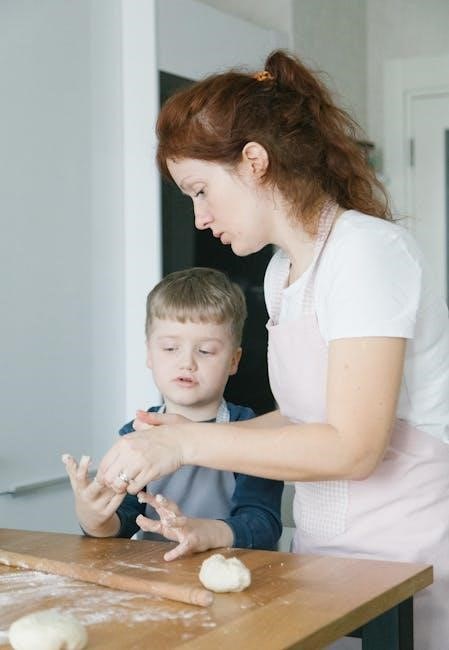The Mrs. Wages Home Canning Guide offers a comprehensive resource for preserving garden produce with step-by-step instructions and over 120 tested recipes for pickles‚ jams‚ and more.
1.1 Overview of the Guide
The Mrs. Wages Home Canning Guide is a comprehensive resource for home canning enthusiasts‚ offering step-by-step instructions and over 120 tested recipes. It covers essential techniques‚ safety tips‚ and creative ideas for preserving fruits‚ vegetables‚ and more. Designed for both beginners and experienced canners‚ the guide emphasizes easy-to-follow methods and high-quality results. From classic pickles to flavorful jams‚ it provides a wide variety of options to suit every taste and skill level‚ ensuring successful and enjoyable canning experiences.
1.2 Importance of Home Canning
Home canning is a valuable skill for preserving fresh produce‚ reducing food waste‚ and enjoying seasonal flavors year-round. It allows individuals to create healthy‚ homemade alternatives to store-bought products‚ free from additives. The Mrs. Wages Guide emphasizes the cost-effectiveness and sustainability of canning‚ making it accessible for families to save money and reduce reliance on processed foods. By following tested methods‚ home canners can ensure safety and quality‚ preserving nutrients and flavors for future meals. This timeless practice promotes self-sufficiency and healthier eating.

About Mrs. Wages
Mrs. Wages is a trusted name in home canning‚ offering a comprehensive guide for preserving food. Her expertise has made her a household name for decades.
2.1 History of Mrs. Wages
Mrs. Wages‚ born in the early 20th century‚ was a pioneer in home canning. Her journey began with a passion for gardening and cooking‚ leading her to develop simple‚ effective canning methods. Recognizing the need for accessible guidance‚ she created her iconic guide‚ which quickly became a trusted resource for home preservers. Her legacy endures as a symbol of self-sufficiency and culinary tradition‚ inspiring generations to embrace the art of canning.
2.2 Reputation as a Trusted Brand
Mrs. Wages has built a steadfast reputation as a trusted brand in home canning. For decades‚ her guide has been a cornerstone for both beginners and experienced canners‚ offering reliable recipes and techniques. Known for its clarity and precision‚ the guide has earned widespread acclaim for ensuring safe and successful canning practices. The brand’s commitment to quality and tradition has solidified its place as a leader in the industry‚ making it a go-to resource for preserving food with confidence and consistency.
Essential Supplies for Home Canning
Stock up on jars‚ lids‚ a canner‚ and utensils like a jar lifter and funnel. Basic ingredients and tools ensure safe‚ efficient canning following Mrs. Wages’ guidelines.
3.1 Basic Canning Equipment
The essential tools for home canning include glass jars‚ lids‚ a canner‚ and a jar lifter. A large pot or water bath canner is necessary for heat processing. Acid-resistant utensils like stainless steel or plastic are recommended to avoid reactions with acidic foods. A clean‚ sturdy workspace and a funnel for filling jars are also crucial. Optional items like a pressure canner can expand your canning capabilities. Always ensure equipment is in good condition and sterilized before use to guarantee safety and success in preserving with Mrs. Wages’ methods.
3.2 Recommended Ingredients and Tools
For successful home canning‚ use fresh‚ high-quality ingredients like ripe fruits‚ crisp vegetables‚ and herbs. Essential tools include a sharp knife‚ cutting board‚ and measuring cups. Acid testers and salt specifically designed for canning are crucial for safety. Non-reactive pots‚ like stainless steel or enamel-coated‚ prevent flavor transfer. A candy thermometer is handy for jams and jellies. Always follow Mrs. Wages’ tested recipes to ensure flavor and safety. Fresh spices and seasonings enhance flavors without compromising preservation. Proper tools and ingredients ensure consistent‚ delicious results every time.
Step-by-Step Canning Process
Prepare‚ sterilize‚ fill‚ and seal jars‚ then process in a water bath. Follow tested recipes and guidelines for safe‚ consistent results every time.
4.1 Preparing Jars and Lids
Wash jars and lids in hot soapy water‚ rinse thoroughly‚ and dry. Jars must be free of residue for proper sealing. Place lids and bands in hot water to soften the rubber‚ ensuring a tight seal. Avoid using damaged or chipped jars‚ as they may not seal properly. Sterilization is not required at this stage‚ but cleanliness is crucial. Follow these steps to ensure jars are ready for filling and sealing. Proper preparation is key to safe and successful canning.
4.2 Sterilization Techniques
Sterilization is crucial for safe home canning. Wash jars‚ lids‚ and utensils in hot soapy water‚ then rinse thoroughly. Place jars and lids in a large pot‚ cover with water‚ and bring to a boil for 10–15 minutes. This ensures all surfaces are germ-free. Let cool slightly before filling. Sterilization prevents contamination and spoilage‚ ensuring your canned goods remain safe to eat. Always follow this step carefully to maintain the quality and safety of your canned products.
4.3 Filling and Sealing Jars
Filling jars correctly is essential for successful canning. Use a clean‚ sterilized utensil to transfer prepared food into hot‚ sterilized jars. Leave the recommended headspace to ensure proper sealing. Remove air bubbles by gently running a non-metallic tool‚ like a plastic spatula‚ around the inside of the jar. Wipe rims with a clean‚ damp cloth to remove any residue. Apply sterilized lids and rings‚ tightening until just finger-tight. Avoid overtightening‚ as this can prevent proper sealing. Process jars in a boiling water bath to complete the seal.
4.4 Processing Jars in a Water Bath
Place filled jars into a large pot or water bath canner‚ ensuring they are fully submerged under boiling water. Use a rack to prevent jars from touching the bottom. Cover the pot and maintain a rolling boil for the recommended time‚ usually 10-30 minutes‚ depending on altitude. After processing‚ turn off the heat and let jars sit for 5 minutes before removing them with a lifter. Proper processing ensures a vacuum seal forms‚ preserving the food safely. Always follow altitude adjustments for accurate results.

Popular Recipes from Mrs. Wages
Mrs. Wages offers a variety of popular canning recipes‚ including classic pickles‚ homemade jams‚ and hearty salsas. These recipes are easy to follow and yield delicious results.
5.1 Classic Pickle Recipes
Mrs. Wages offers timeless classic pickle recipes that are easy to make and bursting with flavor. From traditional dill to sweet and bread & butter pickles‚ these recipes balance tangy and savory notes. The guide provides clear instructions for creating crisp‚ flavorful pickles using fresh cucumbers‚ vinegar‚ and spices. Perfect for snacks‚ sandwiches‚ or as a side‚ these pickles are a staple in home canning. The recipes emphasize proper sterilization and sealing techniques to ensure long-lasting results. Ideal for beginners and experienced canners alike‚ these classic recipes are a must-try.
5.2 Strawberry Jam and Other Fruit Preserves
Mrs. Wages provides simple and delicious recipes for strawberry jam and other fruit preserves‚ perfect for capturing fresh flavors year-round. These recipes use minimal ingredients like strawberries‚ sugar‚ lemon juice‚ and pectin to create a vibrant‚ tangy jam. The guide offers step-by-step instructions for cooking and canning‚ ensuring a smooth‚ spreadable texture. Tips for achieving the perfect set and avoiding common pitfalls are included. Ideal for toast‚ biscuits‚ or as a gift‚ these preserves are a delightful way to enjoy seasonal fruits at any time.
5.3 Salsa and Relish Recipes
Mrs. Wages offers vibrant recipes for homemade salsas and relishes‚ blending fresh flavors for year-round enjoyment. From spicy tomato salsa to tangy corn relish‚ these recipes emphasize balance and zing. The guide provides clear steps for preparing and canning‚ ensuring safety and flavor retention. Tips for adjusting spice levels and acidity are included‚ making these preserves perfect for topping tacos‚ hot dogs‚ or using as a side. Ideal for gift-giving‚ these recipes showcase the versatility of home canning.

Safety Guidelines for Home Canning
Mrs. Wages provides delightful salsa and relish recipes‚ perfect for enhancing meals with fresh flavors. The guide offers step-by-step canning instructions‚ ensuring safety and flavor preservation. Tips for adjusting spice levels and acidity are included‚ allowing customization. From classic tomato salsa to zesty corn relish‚ these recipes are ideal for topping dishes or as gifts. Emphasizing the use of fresh ingredients and clear processes‚ Mrs. Wages makes creating delicious‚ shelf-stable salsas and relishes easy and enjoyable and rewarding.
6.1 Understanding pH Levels
Understanding pH levels is crucial for safe home canning. Mrs. Wages guide explains that pH measures acidity‚ with lower levels indicating higher acidity. Maintaining the right pH ensures food safety‚ preventing spoilage and botulism. High-acid foods like fruits and pickles naturally inhibit bacteria‚ while low-acid foods require added acidity or pressure canning. Testing pH with strips or meters is recommended. Proper acidity also preserves flavor and texture. Always follow tested recipes to achieve safe pH levels‚ especially when altitudes affect canning processes. This ensures your canned goods are safe‚ nutritious‚ and delicious for years to come.
6.2 Avoiding Common Mistakes
Avoiding common mistakes is essential for successful home canning. Overfilling jars can lead to seal failure‚ while underfilling may result in improper vacuum formation. Using outdated or untested recipes risks unsafe pH levels. Neglecting sterilization steps can introduce bacteria‚ and incorrect lid preparation may prevent proper sealing. Processing times must match altitude adjustments to ensure safety. Mrs. Wages guide emphasizes following tested procedures to avoid these errors‚ ensuring safe‚ high-quality canned goods. Attention to detail is key to achieving consistent results and preventing potential spoilage.
6.3 Ensuring Proper Sealing
Ensuring proper sealing is crucial for safe and successful canning. Always use new lids specifically designed for canning‚ as reused lids may fail to seal. Clean and dry jar rims thoroughly before applying lids to prevent residue interference. Heat lids in simmering water to activate the sealing compound. After filling‚ remove air bubbles with a non-metallic utensil to ensure even sealing. Leave the recommended headspace to allow for proper vacuum formation. Process jars in a boiling water bath as directed‚ then let them cool undisturbed to set the seal. Check seals after cooling by lifting jars by their lids.

Tips for Successful Canning
Key tips include selecting fresh produce‚ adjusting recipes for altitude‚ and using time-saving techniques to ensure efficiency and quality in your canning projects.
7.1 Choosing the Right Produce
Selecting fresh‚ ripe‚ and high-quality produce is essential for successful canning. Choose fruits and vegetables that are free from bruises‚ blemishes‚ or signs of spoilage. Opt for varieties known for their flavor and texture when preserved. Avoid overripe produce‚ as it can lead to poor results. For best outcomes‚ use produce at its peak ripeness and follow tested recipes to ensure safety and quality. Proper selection enhances the final product’s taste‚ texture‚ and overall appeal.
7.2 Adjusting for Altitude
Altitude affects canning safety and quality‚ as water boils at lower temperatures at higher elevations. This can impact the effectiveness of heat transfer during processing. For safe canning‚ it’s crucial to adjust processing times or pressures based on your altitude. Use a pressure canner for altitudes above 1‚000 feet to ensure proper sterilization. Always consult a reliable canning guide or the Mrs. Wages resource for specific altitude adjustments to maintain safety and prevent spoilage. Accurate adjustments are vital for achieving consistent‚ high-quality results.
7.3 Time-Saving Techniques
Efficiency is key to enjoyable home canning. Prepare ingredients in bulk to streamline the process. Use a food chopper or mandoline for quick slicing and dicing. Pre-sterilize jars and lids while preparing your recipe to save time. Batch cooking allows for multiple jars to be filled and processed simultaneously. Invest in a wide-mouth funnel to reduce spills and speed up filling. Plan recipes in advance and reuse clean jars to maximize productivity. These tips help make canning faster and more manageable‚ ensuring a smooth experience.

Storing Canned Goods
Store sealed jars in a cool‚ dark‚ dry place to maintain quality. Ensure jars are undamaged and lids are tightly sealed for optimal shelf life and freshness.
8.1 Best Practices for Shelf Life
For optimal shelf life‚ store canned goods in a cool‚ dark‚ dry place with consistent temperatures between 50-70°F. Keep jars upright and sealed tightly to prevent contamination. Avoid exposure to direct sunlight or moisture‚ as this can degrade quality. Check jars for any signs of damage or wear before storage. Use older jars first to maintain inventory rotation. Label jars with dates and contents for easy identification. Properly stored canned goods can last for years‚ retaining flavor and nutritional value.
8.2 Organizing Your Pantry
Organize your pantry by grouping canned goods by type and usage. Use shelves or racks to maximize space and keep jars visible. Label each jar with contents and dates for easy identification. Store frequently used items at eye level‚ while less-used items can go higher or lower. Keep a clean‚ dust-free environment to maintain quality. Regularly check expiration dates and rotate inventory to ensure older items are used first. A well-organized pantry ensures efficiency and makes meal planning easier‚ while also preserving the quality of your canned goods.

Troubleshooting Common Issues
Troubleshoot common canning issues like jar sealing problems or spoilage by checking lids‚ ensuring proper sterilization‚ and maintaining correct processing times to avoid contamination and failure.
9.1 Dealing with Spoilage
Identify spoilage by checking for off smells‚ mold‚ or bubbles in jars. Discard spoiled food immediately to prevent contamination. Always follow tested recipes and guidelines to minimize risks. Ensure jars are properly sterilized and sealed. If a jar doesn’t seal‚ store it in the fridge and use within a few days. Regularly inspect stored jars for signs of spoilage. Proper canning practices‚ like acid levels and processing times‚ are crucial for safety and quality. Stay vigilant to maintain the integrity of your canned goods.
- Inspect jars regularly for signs of spoilage.
- Discard any jars showing mold‚ off odors‚ or swelling.
- Store unsealed jars in the refrigerator for short-term use.
9.2 Fixing Sealing Failures
If a jar fails to seal‚ check the rim for residue and ensure the lid is undamaged. Re-sterilize the jar and lid‚ then reprocess using a water bath. If the issue persists‚ it may be due to incorrect lid tightening or insufficient headspace. Always follow Mrs. Wages guidelines for proper sealing techniques. If reprocessing isn’t possible‚ store the jar in the fridge for immediate use. Regularly inspect jars for signs of failure to ensure long-term preservation success. Proper sealing is critical for safety and shelf life.
- Reprocess unsealed jars promptly using a water bath.
- Check jar rims and lids for cleanliness and damage.
- Store unsealed jars in the refrigerator for short-term use.

Health Benefits of Home Canning
Home canning preserves nutrients by locking in vitamins and minerals during the canning process. It allows for control over sodium and sugar content‚ promoting healthier eating habits and providing fresh flavors year-round.
- Retains nutritional value of fresh produce.
- Reduces reliance on processed foods.
- Supports a balanced diet with homemade options.
- Locks in vitamins and minerals during processing.
- Prevents nutrient degradation over time.
- Preserves fresh flavors and natural goodness.
- Customizable recipes for reduced sodium and sugar.
- Natural alternatives for flavor enhancement.
- Healthier options without compromising preservation.
- Bulk purchases of fruits and vegetables during peak seasons lower costs.
- Reusable jars and equipment provide long-term savings.
- Homemade canned goods reduce reliance on store-bought alternatives.
- Bulk purchasing lowers costs per unit.
- Preserving leftovers reduces waste.
- Homemade canned goods are often cheaper than store-bought.
- Airtight seals prevent spoilage and contamination.
- Proper storage conditions extend shelf life.
- Canned goods remain nutritious for years.
10.1 Preserving Nutrients
Home canning effectively preserves nutrients by sealing fresh produce in airtight jars‚ protecting vitamins and minerals from degradation; This method minimizes nutrient loss compared to freezing or dehydration. Freshness is locked in immediately‚ maintaining the food’s natural flavors and nutritional integrity. Canning also prevents oxidation‚ which can degrade vitamins like C and B. By following tested recipes‚ you ensure optimal retention of essential nutrients‚ making home-canned foods a healthy and sustainable choice for year-round enjoyment.
10.2 Reducing Sodium and Sugar
Home canning allows for precise control over sodium and sugar content‚ enabling healthier options. Mrs. Wages recipes often include low-sodium and low-sugar alternatives‚ catering to dietary preferences. By using fresh ingredients and minimal additives‚ you can significantly reduce reliance on salt and sugar for flavor. Natural sweeteners like honey or stevia can substitute refined sugars‚ while herbs and spices enhance taste without added sodium. This approach promotes healthier eating while maintaining the quality and safety of canned goods.
Cost-Effectiveness of Home Canning
Home canning is economical‚ allowing you to preserve seasonal produce and reduce food waste. Buying in bulk and reusing jars saves money over time.
11.1 Saving Money on Groceries
Home canning helps reduce grocery expenses by allowing you to buy produce in bulk during peak seasons and preserve it for future use. This method minimizes food waste and enables you to avoid costly store-bought alternatives. By canning seasonal fruits and vegetables‚ you can enjoy your favorite foods year-round without the higher prices. Additionally‚ reusable jars and equipment contribute to long-term savings‚ making home canning a budget-friendly way to stock your pantry.
11.2 Long-Term Food Storage
Home canning with Mrs. Wages ensures long-term food storage by creating airtight‚ shelf-stable products. Properly canned goods can last for years when stored in a cool‚ dark place. This method allows families to enjoy seasonal produce year-round and maintain a stockpile for emergencies. The sealed jars prevent spoilage and contamination‚ ensuring food remains fresh and nutritious. With Mrs. Wages’ trusted techniques‚ you can confidently store food for extended periods‚ reducing reliance on perishable items and saving money over time.

Creative Variations and Ideas
Explore unique flavor combinations and presentation ideas to elevate your canned creations. Customize recipes with spices‚ herbs‚ or exotic ingredients for personalized touches. Get creative!
12.1 Experimenting with New Flavors
Take your canning to the next level by experimenting with unique flavor combinations. Try adding a hint of spice‚ like cumin or chili flakes‚ to pickles for a bold twist. Infuse jams with citrus zest or herbs for a refreshing taste. Mix sweet and tangy elements‚ such as balsamic glaze in relishes‚ for depth. Don’t forget to explore international flavors‚ like Korean chili paste or Indian spices‚ to create one-of-a-kind recipes. Balancing flavors is key‚ so start with small batches to perfect your creations.
12.2 Gift Ideas Using Canned Goods
Canned goods make thoughtful and practical gifts for family‚ friends‚ and neighbors. Create personalized gift baskets filled with homemade jams‚ pickles‚ and salsas. Add decorative touches like ribbons‚ labels‚ and handwritten notes for a personal flair. Pair canned items with fresh bread‚ cheeses‚ or homemade spices for a complete gift set. Consider themed baskets‚ such as a “Taste of Summer” with preserved fruits or a “Spicy Delight” with bold relishes. These gifts are not only delicious but also showcase your creativity and effort.
The Mrs. Wages Home Canning Guide empowers you to preserve freshness and creativity year-round. With its comprehensive instructions and inspiring recipes‚ it makes canning accessible and rewarding for everyone‚ ensuring delicious and personalized results every time. This guide is your key to unlocking the joy of home canning and sharing it with others through thoughtful gifts and meals. Happy canning!
13.1 Summary of Key Points
The Mrs. Wages Home Canning Guide offers a comprehensive approach to preserving food‚ covering essential supplies‚ step-by-step processes‚ and safety tips. It emphasizes the importance of proper sterilization‚ pH levels‚ and sealing techniques to ensure safe and delicious results. With a focus on creativity‚ the guide provides classic recipes and encourages experimenting with new flavors. Additionally‚ it highlights the cost-effectiveness and health benefits of home canning‚ making it a valuable resource for both beginners and experienced canners. This guide truly simplifies the art of canning for everyone.
13.2 Encouragement to Start Canning
Embark on your canning journey with confidence using the Mrs. Wages Home Canning Guide! This resource makes preserving food accessible and rewarding‚ whether you’re a novice or an experienced canner. With clear instructions and tried-and-true recipes‚ you’ll create delicious‚ healthy‚ and cost-effective meals. Canning allows you to enjoy seasonal flavors year-round while reducing waste and saving money. Take the first step today and discover the joy of creating homemade goodness that your family and friends will cherish. Let Mrs. Wages guide you to success in the kitchen!

Additional Resources
Explore the Mrs. Wages website for tutorials‚ recipes‚ and troubleshooting guides. Join canning forums and social media groups for tips and inspiration from experienced canners worldwide.
14.1 Recommended Reading
Enhance your canning journey with books like “The Ball Blue Book of Canning and Preserving” and “Mrs. Wages Complete Guide to Canning.” These resources offer step-by-step guides‚ safety tips‚ and creative recipes. Visit the Mrs. Wages website for downloadable guides and instructional videos. Additionally‚ “Putting Food By” by Janet Greene and “The Encyclopedia of Country Living” provide comprehensive insights. These materials ensure you stay informed and inspired‚ covering everything from basic techniques to advanced methods for preserving food successfully.
14.2 Online Communities and Forums
Join online communities like the Mrs. Wages Facebook group or forums such as GardenWeb and Reddit’s r/canning. These platforms connect enthusiasts‚ offering tips‚ troubleshooting‚ and recipe ideas. Websites like Food52 and Serious Eats feature discussions on canning techniques. Engage with experts and hobbyists to share experiences and gain insights. Online forums are invaluable for addressing specific challenges and discovering creative ideas to enhance your home canning journey with Mrs. Wages products and beyond;



